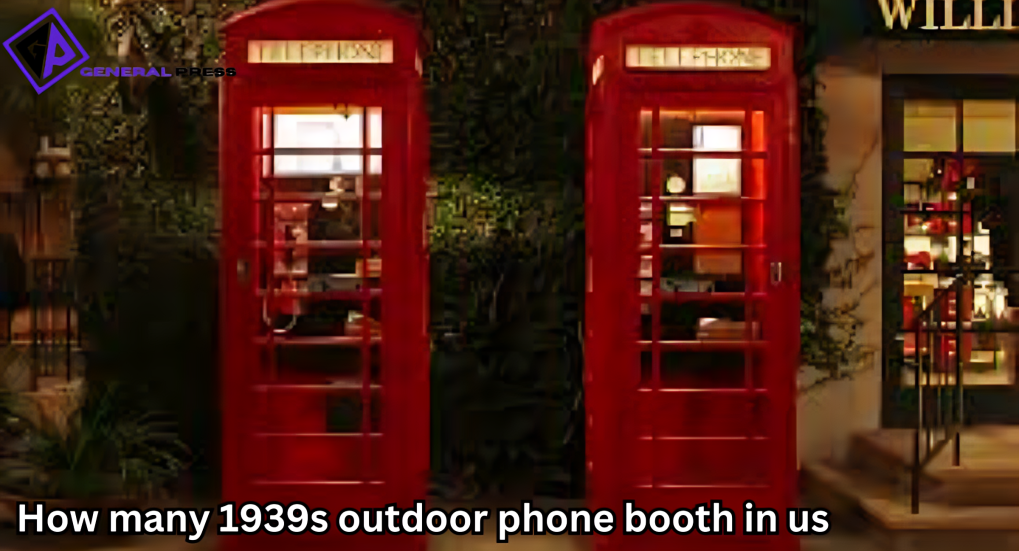The outdoor phone booth is a symbol of a bygone era, evoking memories of a time when communication required coins, rotary dials, and physical connections to landlines. The 1930s, including the 1939 models, feature some of the most iconic phone booths in American history. As modern technology continues to advance, these booths are becoming increasingly rare. But how many 1939 outdoor phone booths still exist in the United States today? This article explores the history, significance, and current status of these historical relics.
The Rise of the Outdoor Phone Booth
The outdoor phone booth became popular in the early 20th century, offering a convenient way for people to make calls. The first coin-operated public telephone was installed in Hartford, Connecticut, in 1889. By the 1930s, phone booths had become a common sight across cities and rural areas in the United States.
The 1939 outdoor phone booths combined functionality with the Art Deco aesthetic, reflecting the design sensibilities of their era. These booths were made of steel and glass, featuring sleek lines and minimalist designs reflecting late 1930s modernist trends. Found in train stations, street corners, and parks, these booths connected people long before the advent of mobile phones.
The Decline of the Phone Booth
Also Read: North Point Church Pastor Resigns: What It Means for the
The rise of cell phones in the 1980s and their widespread adoption led to a sharp decline in phone booth usage. Telecommunications companies found it increasingly difficult to maintain these booths, as revenue from coin-operated calls plummeted. By the early 21st century, most outdoor phone booths were removed, with remaining ones becoming nostalgic or quirky urban artifacts.
For booths dating back to 1939, survival has been even more challenging. Many booths were replaced during mid-20th-century upgrades, and those remaining often succumbed to weathering, vandalism, or neglect.
How Many 1939 Outdoor Phone Booths Still Exist in the U.S.?
Determining the exact number of 1939 outdoor phone booths still standing in the United States is no easy task. Unlike monuments or historical buildings, phone booths are not typically cataloged in national registries. However, preservationists and phone booth enthusiasts have worked to identify and restore these relics wherever possible.
Estimates suggest that fewer than 100 outdoor phone booths from 1939 may still exist in the U.S., with many of them no longer operational. Some of these booths have been preserved in museums or private collections, while others remain in public spaces as decorative or nostalgic elements. For example:
- Museums and Historical Societies: Several museums dedicated to telecommunications history, such as the Telephone Museum in Washington State, have restored and displayed vintage phone booths, including models from the 1930s.
- Private Collectors: Enthusiasts and collectors often scour flea markets, salvage yards, and auctions to find and restore antique phone booths.
- Urban Artifacts: A handful of 1939 phone booths can still be found in their original locations, albeit as non-operational relics. Some cities have chosen to keep these booths as historical markers, showcasing the evolution of public communication infrastructure.
Restoration and Preservation Efforts
Preserving a 1939 outdoor phone booth is no small feat. Restoration typically involves repairing or replacing damaged parts, such as glass panels, metal frames, and electrical components. In some cases, original materials are no longer available, requiring restorers to fabricate custom parts or use modern substitutes.
Organizations and individuals dedicated to preservation often work to ensure that these booths remain true to their original designs. This includes maintaining the Art Deco styling and even restoring the original phone units, complete with rotary dials and coin slots.
The Cultural Significance of Outdoor Phone Booths
The 1939 outdoor phone booth represents more than just a piece of telecommunications history; it is a cultural icon. These booths have been immortalized in literature, film, and art, serving as backdrops for countless scenes of drama, comedy, and romance. Think of Superman’s transformation scenes in comic books and movies or the mysterious allure of the red phone booths in London, which have a similar cultural resonance.
In the United States, the few remaining 1939 phone booths are a reminder of a time when technology was tangible, deliberate, and rooted in place. Unlike today’s smartphones, which offer instant and portable communication, the phone booth required users to step into a dedicated space, often creating a moment of solitude and focus.
The Future of 1939 Phone Booths
As these booths continue to age, their preservation becomes increasingly important. Local governments, historical societies, and private individuals can play a vital role in ensuring that these relics are not lost to time. Some cities have even repurposed old phone booths for modern use, transforming them into mini-libraries, Wi-Fi hotspots, or art installations.
While it is unlikely that outdoor phone booths will ever return to their former prominence, their legacy endures. The 1939 models, in particular, serve as a testament to the innovation and design sensibilities of their era.
FAQs:
1. How many 1939 outdoor phone booths are still in existence in the U.S.?
Estimates suggest fewer than 100 outdoor phone booths from 1939 remain in the U.S. Many are no longer operational but have been preserved in museums, private collections, or urban spaces.
2. Why are there so few 1939 outdoor phone booths left?
The decline in phone booth use began with the rise of cell phones in the 1980s. Many of the 1939 booths were removed or dismantled in the mid-20th century, with the surviving booths often succumbing to weathering, vandalism, or neglect.
3. Where can I find one of these 1939 outdoor phone booths today?
Some of these vintage phone booths are preserved in museums dedicated to telecommunications history, such as the Telephone Museum in Washington State. A few still stand in public spaces as nostalgic markers or urban artifacts.
4. Are any of the remaining 1939 outdoor phone booths still functional?
Most remaining 1939 phone booths are no longer functional. However, some have been restored and remain in use for decorative or historical purposes, and a few have been repurposed into art installations, mini-libraries, or Wi-Fi hotspots.
5. How are 1939 phone booths preserved or restored?
Preservation efforts typically involve repairing or replacing damaged components like glass panels, metal frames, and rotary phones. In cases where original materials are unavailable, custom parts or modern substitutes are fabricated to maintain authenticity.
Conclusion
Though their numbers are dwindling, the 1939 outdoor phone booths that remain in the United States are cherished symbols of a bygone era. These relics tell the story of a time when communication was bound by physical constraints and when design and functionality merged seamlessly. Whether preserved in museums, restored by collectors, or left standing as silent witnesses to history, these booths remind us of how far we have come—and how much we can still appreciate the past.
So, the next time you pass by an old phone booth, take a moment to appreciate its history and the countless stories it has silently witnessed over the decades. It may not be operational, but its presence is a call to remember the simpler, slower-paced days of 20th-century life.




